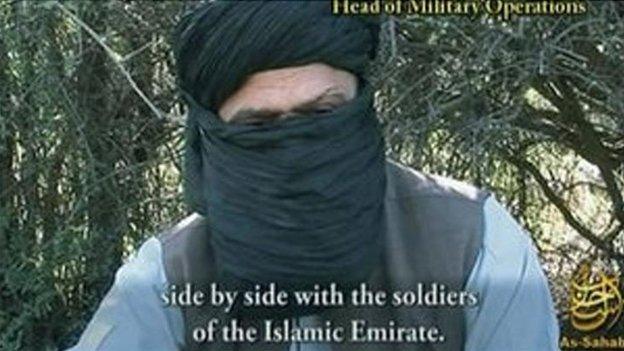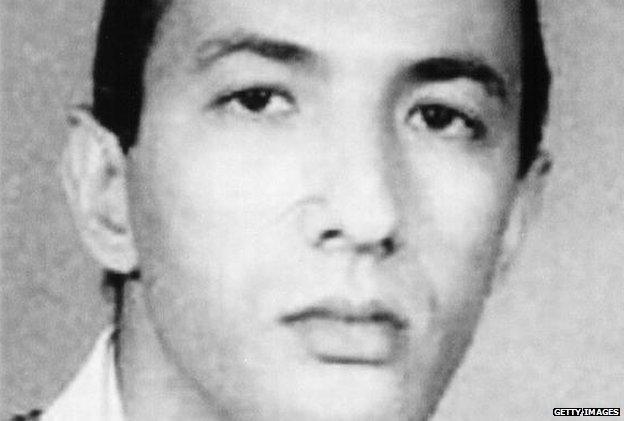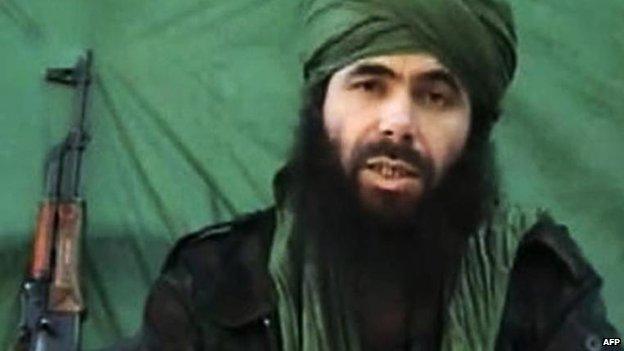Al-Qaeda's remaining leaders
- Published
Al-Qaeda has evolved as prominent figures are killed - including, of course, its leader Osama Bin Laden in 2011 - and the geographical focus of militant activity shifts.
Here we profile some of the most prominent names:
Ayman al-Zawahiri
Ayman al-Zawahiri, an eye surgeon who helped found the Egyptian militant group Islamic Jihad, was named as the new leader of al-Qaeda on 16 June 2011, a few weeks after Osama Bin Laden's death.
In a statement, al-Qaeda vowed to continue its jihad under the new leadership against "crusader America and its servant Israel, and whoever supports them".

Zawahiri was already the group's chief ideologue and was believed by some experts to have been the "operational brains" behind the 11 September 2001 attacks in the US.
Zawahiri was number two - behind only Bin Laden - in the 22 "most wanted terrorists" list announced by the US government in 2001 and continues to have a $25m (£16m) bounty on his head.
One of his wives and two of their children were killed in a US air strike in late 2001.
Zawahiri went into hiding after a US-led coalition overthrew the Taliban. Security analysts believe he is most likely to be concealed in the Afghan-Pakistan border region, although he has continued to evade capture and his precise whereabouts are unknown.
In January 2006, the US launched an airstrike on Damadola, a Pakistani village near the Afghan border where they believed Zawahiri was hiding, killing 18 villagers including four children.
US sources suggested he was among the dead in international media over the following days - only for a video to be released showing that he was unharmed.
Zawahiri has been one of al-Qaeda's most prominent spokesman, appearing in dozens of videos and audiotapes since 2003 - most recently in September 2014, when he called for an Islamist resurgence in India.
He has been indicted in the US for his role in the 1998 US embassy bombings in Africa, and was sentenced to death in Egypt in absentia for his activities with Islamic Jihad during the 1990s.
In June 2013 Zawahiri called for the radical Islamist group Islamic State (IS) to leave Syria and instead focus on Iraq, and in February 2014 al-Qaeda severed all ties with the group altogether.
Khalid al-Habib
Khalid al-Habib, thought to be either Egyptian or Moroccan, was identified in a November 2005 video as al-Qaeda's field commander in south-east Afghanistan, while Abd al-Hadi al-Iraqi was named as its commander in the south-west.
In early 2006, Pakistani officials reported that Habib had died in a US airstrike near the Afghan border, but Pakistani security officials have since retracted that claim, saying that no al-Qaeda leaders died.

Habib seems to have assumed overall command after al-Iraqi's capture in 2006.
He was described as al-Qaeda's "military commander" in July 2008.
US military officials say he oversees al-Qaeda's "internal" operations in Afghanistan and northern Pakistan.
Habib may be operating under an assumed identity, according to some analysts. One of his noms-de-guerre is believed to be Khalid al-Harbi.
Saif al-Adel
An Egyptian in his late 40s or early 50s, Saif al-Adel is the nom-de-guerre of a former Egyptian army colonel, Muhamad Ibrahim Makkawi. He travelled to Afghanistan in the 1980s to fight Soviet forces with the mujahideen.

Adel was once Osama Bin Laden's security chief, and assumed many of military commander Mohammed Atef's duties after his death in a US air strike in November 2001.
He is suspected of being a member of the group which assassinated former Egyptian President Anwar Sadat in 1981.
In 1987, Egypt accused Adel of trying to establish a military wing of the militant Islamic group al-Jihad, and of trying to overthrow the government.
He is believed to have been involved in the 1998 US embassy bombings in East Africa, training the Somali fighters who killed 18 US servicemen in Mogadishu in 1993, and instructing some of the 11 September 2001 hijackers.
Following the invasion of Afghanistan in 2001, Adel is believed to have fled to Iran with Suleiman Abu Ghaith and Saad Bin Laden, a son of the late al-Qaeda leader. They were allegedly then held under house arrest by the Iran's Islamic Revolutionary Guard Corps (IRGC). Iran has never acknowledged their presence.
Abu Ghaith was arrested in Jordan and extradited to the US in March 2013.
Recent reports say Adel may have been released and made his way to northern Pakistan, along with Saad Bin Laden - but a report from 2011 suggested he had returned to Iran.
The US has offered up to $5m for information on his whereabouts.
Mustafa Hamid
Mustafa Hamid, the father-in-law of Saif al-Adel, served as instructor in tactics at an al-Qaeda camp near Jalalabad and is the link between the group and Iran's government, according to the US.
After the fall of the Taliban, he is said to have negotiated the safe relocation of several senior al-Qaeda members and their families to Iran. In mid-2003, Hamid was arrested by the Iranian authorities, but one report says he was released in 2011 and returned to Egypt after its revolution.
Matiur Rehman
Matiur Rehman is a Pakistani militant who has been identified as al-Qaeda's planning chief. He is said to have been an architect of the foiled "liquid bomb" plot to explode passenger aircraft over the Atlantic in 2006.
He has also been identified by Pakistani police as being involved in the kidnapping in 2002 of Wall Street Journal reporter Daniel Pearl, who was subsequently murdered, and was last reported to be hiding in Pakistan.
Abu Khalil al-Madani
Little is known about Abu Khalil al-Madani, who was identified as a member of al-Qaeda's Shura council in a July 2008 video. His name suggests he is Saudi.
Abou Mossab Abdelwadoud
A former university science student and infamous bomb-maker, Abdelwadoud is the leader of al-Qaeda in the Islamic Maghreb (AQIM).

He became leader of the head of the Algerian Islamist militant organisation, the Salafist Group for Preaching and Combat (GSPC), in mid-2004, succeeding Nabil Sahraoui after he was killed in a major army operation.
After university in 1995, Abdelwadoud joined the Armed Islamist Group (GIA), a precursor to the GSPC which shared its aim of establishing an Islamic state in Algeria. He is said to have become a member of the GSPC in 1998.
Abdelwadoud, whose real name is Abdelmalek Droukdel, was one of the signatories to a statement in 2003 announcing an alliance with al-Qaeda.
In September 2006, the GSPC said it had joined forces with al-Qaeda, and in January 2007 it announced it had changed its name to "al-Qaeda in the Land of the Islamic Maghreb" to reflect its allegiance. Abdelwadoud said he had consulted Ayman al-Zawahiri about the group's plans.
Three months later, 33 people were killed in bomb attacks on official buildings in Algiers. Abdelwadoud allegedly supervised the operation. That December, twin car bombs killed at least 37 people in the capital.
The ambitions of the group's leadership widened, and it subsequently carried out a number of attacks across North Africa. It also declared its intention to attack Western targets and send jihadis to Iraq. Westerners have also been kidnapped and held for ransom; some have been killed.
In November 2012, Abdelwadoud appeared in a video praising his fighters and jihadist allies as "saviours" of the Mali's unity as they consolidated their hold on the country's north. Their territorial advance was only halted by the intervention of French forces.